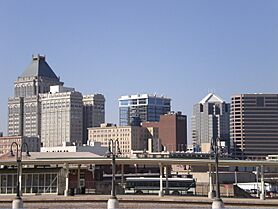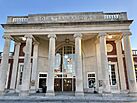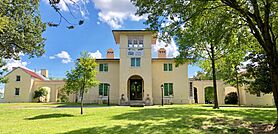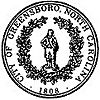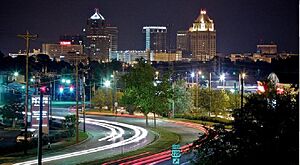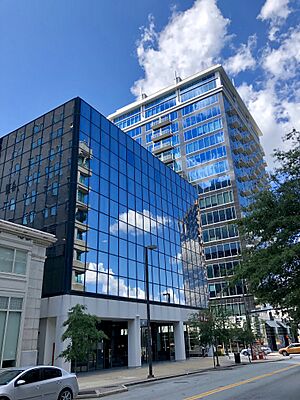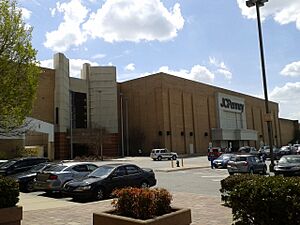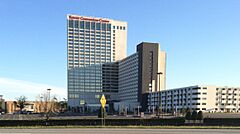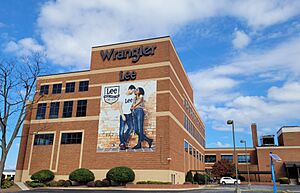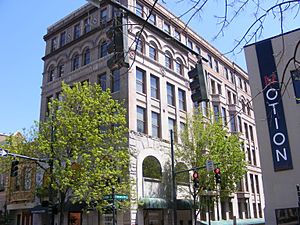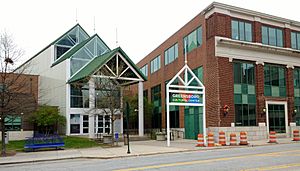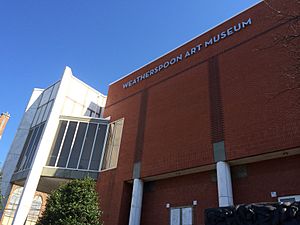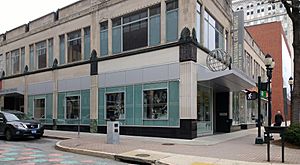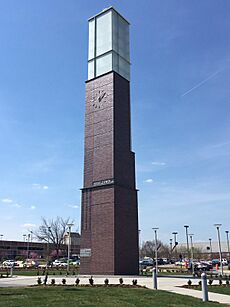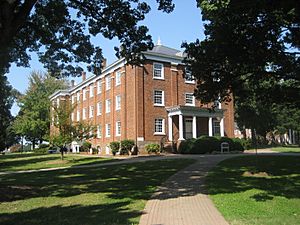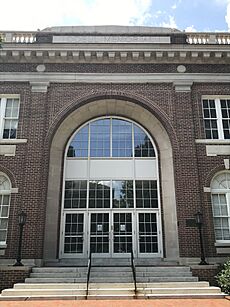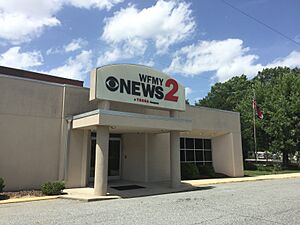Greensboro, North Carolina facts for kids
Quick facts for kids
Greensboro
|
|||||
|---|---|---|---|---|---|
|
|
|||||
|
|||||
| Nicknames:
The Gate City, The GSO, G'Boro, The Boro, Tournament Town
|
|||||
| Country | United States | ||||
| State | North Carolina | ||||
| County | Guilford | ||||
| Established | 1808 | ||||
| Named for | Nathanael Greene | ||||
| Government | |||||
| • Type | Council–manager | ||||
| • Body | Greensboro City Council | ||||
| Area | |||||
| • Total | 136.65 sq mi (353.92 km2) | ||||
| • Land | 131.41 sq mi (340.35 km2) | ||||
| • Water | 5.24 sq mi (13.57 km2) 3.83% | ||||
| Elevation | 897 ft (273 m) | ||||
| Population
(2020)
|
|||||
| • Total | 299,035 | ||||
| • Estimate
(2023)
|
302,296 | ||||
| • Rank | 3rd in North Carolina 69th in United States |
||||
| • Density | 2,275.59/sq mi (878.61/km2) | ||||
| • Urban | 338,928 (US: 120th) | ||||
| • Urban density | 2,001.9/sq mi (772.9/km2) | ||||
| • Metro | 789,842 (US: 78th) | ||||
| GDP | |||||
| • Greensboro (MSA) | $41.4 billion (2022) | ||||
| Time zone | UTC−5 (EST) | ||||
| • Summer (DST) | UTC−4 (EDT) | ||||
| ZIP Codes |
27401–27413, 27415, 27420, 27429, 27435, 27438, 27455, 27495, 27497–27499
|
||||
| Area code | 336, 743 | ||||
| FIPS code | 37-28000 | ||||
| GNIS feature ID | 2403745 | ||||
Greensboro is a city in North Carolina, United States. It is the county seat of Guilford County. In 2020, about 299,035 people lived here. This makes Greensboro the third-largest city in North Carolina. Only Charlotte and Raleigh are bigger.
Greensboro is often called "The Gate City." This is because three major highways meet here. These are Interstate 40, Interstate 85, and Interstate 73. The city was planned in 1808 around a central courthouse. This made it easier for people to reach the county's main offices.
Many fun places are in Greensboro. These include the Greensboro Science Center, the International Civil Rights Museum, and the Steven Tanger Center for the Performing Arts. You can also visit the Weatherspoon Art Museum. The city hosts exciting events like the North Carolina Folk Festival.
Greensboro is also known for sports. The Greensboro Coliseum Complex hosts many big events. These include basketball tournaments and concerts. Local sports teams include the Greensboro Grasshoppers (baseball) and the Greensboro Swarm (basketball). The city is nicknamed "Tournament Town" because it hosts so many sports events.
Contents
- Greensboro's History: A Journey Through Time
- Greensboro's Location and Climate
- People and Culture in Greensboro
- Greensboro's Economy: How People Work
- Arts and Attractions: Fun Things to Do in Greensboro
- Sports in Greensboro: Tournament Town!
- Education in Greensboro
- Media in Greensboro
- Transportation in Greensboro
- Sister Cities
- Images for kids
- See also
Greensboro's History: A Journey Through Time
How Greensboro Began
Long ago, the Saura people lived in the area that is now Greensboro. They were a Native American group. Around 1750, Quaker families from Pennsylvania moved here. They started a community called New Garden. This became an important Quaker center in North Carolina.
After the American Revolutionary War, the city was named after Major General Nathanael Greene. He was a hero who fought in the Battle of Guilford Court House in 1781. Even though his American forces lost the battle, they greatly weakened the British army. This helped lead to America's victory.
Greensboro was built in the middle of Guilford County. It was once a thick forest. The land was bought from the Saura people. The city grew slowly at first. By 1821, about 369 people lived there.
Growing with Railroads and Industry
In the 1840s, Greensboro became a stop on a new railroad line. This was a big deal! The railroads helped the city grow a lot. Greensboro became known as the "Gate City" because it was a major transportation hub. Trains carried goods like cotton to and from textile mills. Many factories built homes for their workers nearby.
Some beautiful old buildings were built during this time. One example is Blandwood Mansion and Gardens. It was built in 1795 and later expanded. It's famous for being one of the first Tuscan-style villas in America.
Greensboro During the Civil War
During the American Civil War, many people in this part of North Carolina supported the Union. Guilford County did not want to leave the United States. But once North Carolina joined the Confederacy, some people fought for the South.
In April 1865, Greensboro played a special role. The Confederate President, Jefferson Davis, and his government came to Greensboro. They had to leave their capital city, Richmond, Virginia. Greensboro was the last place where the entire Confederate government met. Some people even call it the Confederacy's final capital city.
Soon after, the war ended. Confederate soldiers in Greensboro gave up their weapons and went home.
Becoming a Modern City
After the war, Greensboro rebuilt its industries. In the 1890s, new textile factories opened. This made Greensboro a major center for the Southern textile industry. Factories made denim, flannel, and overalls. The city grew quickly, and new buildings were constructed.
Greensboro kept growing in the 20th century. New companies like Vicks Chemical Co. (known for VapoRub) started here. The city became known as a well-planned community. It focused on education and parks.
Greensboro has two large public universities: North Carolina A&T State University and the University of North Carolina at Greensboro. These universities have played a big role in the city's history and growth.
The Civil Rights Movement in Greensboro
In the 1950s, public places in Greensboro were separated by race. This was due to unfair laws. Black people were often treated differently.
On February 1, 1960, something important happened. Four black college students from North Carolina A&T sat down at an "all-white" lunch counter at Woolworth's. They were refused service but would not leave. This act of peaceful protest was called a "sit-in." Hundreds of people joined them. These sit-ins quickly spread across the South. They helped end segregation at lunch counters and other places.
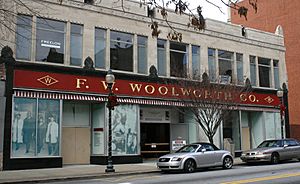
Today, the original Woolworth's building is the International Civil Rights Center and Museum. It opened on the 50th anniversary of the sit-ins. A part of the lunch counter is even on display at the Smithsonian in Washington, D.C.
More protests happened in 1963. People wanted all public places to be fair. They also wanted fair hiring practices. Thousands of protesters marched through downtown Greensboro. Many students were arrested for peacefully protesting. These actions helped bring about changes in the city.
Important Events in the Late 20th Century
In May 1969, students at James B. Dudley High School protested. They were upset that a popular student could not run for class president. Students from North Carolina A&T joined them. The protests grew, and the National Guard was called in. This event led to important discussions about how the city handled student protests.
On November 3, 1979, a sad event called the Greensboro massacre occurred. During a protest, gunfire broke out between two groups. Five people were killed. This event was shown on TV around the world. Later, a jury found some police officers and others responsible for damages. This money went to a fund to help civil rights.
Greensboro Today: The 21st Century
Today, Greensboro is still a center for the textile industry. Many big companies have their main offices here. Rail traffic is also important for the city's economy. Greensboro is a major hub for freight trains.
The city is also attracting new businesses. These include high-tech, aviation, and logistics companies. In 2021, Toyota Motor North America announced it would build a large battery plant here. HondaJet also has a manufacturing facility in Greensboro. Soon, Boom Supersonic will build a factory at the airport for its supersonic passenger planes.
Greensboro's Location and Climate
Where is Greensboro Located?
Greensboro is in the middle of North Carolina. It sits among rolling hills. It's about halfway between the Blue Ridge Mountains to the west and the Atlantic beaches to the east.
The city is a major crossroads. I-40, I-73, and I-85 all meet here. This makes it easy to travel to other big cities. For example, Greensboro is about 29 miles (47 km) east of Winston-Salem.
Exploring Greensboro's Neighborhoods
Greensboro has many interesting areas.
Downtown Greensboro: A Lively Center
Downtown Greensboro has changed a lot recently. New buildings, homes, and offices have been built. The Southside neighborhood is a great example. It was once struggling but is now a lively area. It's easy to walk around and find shops and services. The Elon University School of Law helped bring new life to downtown.
Shopping and Entertainment Hubs
The Four Seasons Town Centre is a large, three-story shopping mall. It's next to the Joseph S. Koury Convention Center and Sheraton Hotel. This convention center is one of the biggest in the Southeast.
The Greensboro Coliseum Complex is a huge place for events. It has a 22,000-seat arena, a theater, and exhibition halls. It hosts sports, concerts, and shows. The Greensboro Aquatic Center, for swimming and diving, is also here.
The Triad Airport Area
The Piedmont Triad International Airport is home to major businesses. In 1998, FedEx built a large cargo hub here. This helps move packages across the country. HondaJet also has a factory at the airport. They make small private jets. Soon, Boom Supersonic will build a factory to make super-fast passenger planes.
Greensboro's Weather: What to Expect
Greensboro has four different seasons. Winters are usually cool and short. You might see some snow, especially in January and February. Summers are hot and humid. Temperatures can reach 90°F (32°C) or higher. Spring and autumn are mild and pleasant.
Thunderstorms are common in spring and summer. Sometimes, strong tornadoes can hit the area. One famous tornado in 1936 caused a lot of damage.
People and Culture in Greensboro
Who Lives in Greensboro?
In 2020, Greensboro had almost 300,000 people. The city is very diverse. About 41% of the people are Black or African American. About 38% are non-Hispanic White. There are also growing Asian and Hispanic/Latin American communities. This mix of cultures makes Greensboro a vibrant place to live.
Religion in Greensboro
Most people in Greensboro are Christian. Many belong to Baptist or Methodist churches. There are also Presbyterian, Catholic, and other Christian groups. Greensboro also has communities of Muslims and Jewish people.
Greensboro's Economy: How People Work
Greensboro's economy has traditionally focused on textiles, tobacco, and furniture. Because of its central location, it's also a big hub for shipping and logistics. Many large companies have their headquarters or major operations here. These include Honda Aircraft Company, Mack Trucks, Volvo Trucks, and The Fresh Market.
City leaders are working to bring new types of businesses to Greensboro. They want to attract companies in nanotech, high-tech, and aviation. The local universities have even opened a joint research park to help with this.
Top Employers in Greensboro
Many people in Greensboro work for large organizations. The biggest employer is Guilford County Schools, which runs the public schools. Cone Health (a healthcare system) and the City of Greensboro are also major employers. The universities, University of North Carolina at Greensboro and North Carolina A&T State University, also employ many people.
Main Industries in Greensboro
The top industries in Greensboro include:
- Trade, Transportation, and Utilities: This involves moving goods and providing services like electricity.
- Professional and Business Services: Jobs like accounting, legal services, and consulting.
- Manufacturing: Making products, especially textiles and vehicles.
- Education and Health Services: Working in schools, colleges, hospitals, and clinics.
- Government: Jobs with the city, county, and state governments.
- Leisure and Hospitality: Working in hotels, restaurants, and entertainment.
- Financial Activities: Jobs in banking, insurance, and investments.
Arts and Attractions: Fun Things to Do in Greensboro
Greensboro has a lively arts scene.
- The Carolina Theatre of Greensboro hosts many performances. It's home to the Greensboro Ballet and other local groups.
- The Greensboro Cultural Center has over 25 arts groups, art galleries, and a sculpture garden.
- The Greensboro Symphony Orchestra performs classical and pop concerts.
- The Weatherspoon Art Museum at UNC Greensboro has a great collection of modern art.
- The Steven Tanger Center for the Performing Arts is a new venue. It hosts big Broadway shows like Wicked and Hamilton.
Popular Attractions to Visit
Greensboro has many fun places to visit:
- Blandwood Mansion and Gardens: A historic home that is now a museum. It's famous for its unique Tuscan-style architecture.
- International Civil Rights Center and Museum: Located in the former Woolworth's building, this museum tells the story of the Greensboro sit-ins and the Civil Rights Movement.
- Greensboro Science Center: A family-friendly science museum, planetarium, and zoo.
- Guilford Courthouse National Military Park: This park remembers the Battle of Guilford Court House from the Revolutionary War.
- Greensboro Coliseum Complex: A huge venue for sports, concerts, and other events.
- Wet 'n Wild Emerald Pointe: A large water park with many slides and rides.
- First National Bank Field: Home of the Greensboro Grasshoppers baseball team.
- Greensboro has over 70 miles (113 km) of hiking and biking trails. You can explore lakes, parks, and downtown areas.
Shopping in Greensboro
Greensboro has many places to shop. The Four Seasons Town Centre is a large indoor mall. Friendly Center is an outdoor shopping area with many stores and restaurants. You can also find unique shops and art galleries in the revitalized downtown Elm Street area.
Sports in Greensboro: Tournament Town!
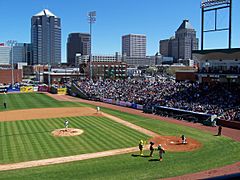
Greensboro is known as "Tournament Town" because it hosts so many sports events.
- The Greensboro Grasshoppers are a minor league baseball team. They play at First National Bank Field.
- The Greensboro Swarm is a professional basketball team. They play at the Greensboro Coliseum Fieldhouse.
- The Carolina Dynamo is a semi-professional soccer team.
- The Wyndham Championship is a professional golf tournament. It's held every year at Sedgefield Country Club.
Greensboro also hosts many college sports events. The Greensboro Coliseum Complex has hosted the ACC men's basketball tournament many times. It even hosted the NCAA Men's Basketball Final Four once!
| Clubs | Sport | League | Stadium |
|---|---|---|---|
| Greensboro Grasshoppers | Baseball | High-A East – South Division | First National Bank Field |
| Greensboro Swarm | Basketball | NBA G League | Greensboro Coliseum Fieldhouse |
| Carolina Cobras | Indoor football | National Arena League | Greensboro Coliseum Complex |
| Carolina Dynamo | Soccer | USL League Two | Macpherson Stadium |
| Greensboro Roller Derby | Roller Derby | Women's Flat Track Derby Association | Greensboro Coliseum |
Education in Greensboro
Colleges and Universities
Greensboro has many colleges and universities:
- Bennett College
- Elon University School of Law
- Greensboro College
- Guilford College
- North Carolina Agricultural and Technical State University (A&T)
- University of North Carolina at Greensboro (UNCG)
- ECPI University
- Guilford Technical Community College
Students at these colleges can sometimes take classes at other schools in the area. This is thanks to the Greater Greensboro Consortium.
Public Schools
Greensboro's public schools are part of Guilford County Schools. This is the third-largest school system in North Carolina. It serves about 71,000 students.
Greensboro has some historic high schools. Grimsley High School was founded in 1899. Weaver Academy is a special high school for students interested in arts and technology. The Early College at Guilford is a top-ranked public school in North Carolina.
Private Schools
Greensboro also has many private schools. These include Greensboro Day School, Our Lady of Grace Catholic School, and New Garden Friends School. There are also two boarding schools nearby: the American Hebrew Academy and the Oak Ridge Military Academy.
Media in Greensboro
Newspapers
The main daily newspaper in Greensboro is the Greensboro News & Record. The Triad Business Journal covers local business news. There are also free weekly newspapers like Yes! Weekly and Triad City Beat. The Carolina Peacemaker focuses on the African-American community.
Television and Radio
Greensboro has many TV stations, including:
- WFMY-TV (CBS)
- WGHP (Fox)
- WXII-TV (NBC)
- WXLV-TV (ABC)
- WMYV-TV (MyNetworkTV)
You can also listen to many radio stations in Greensboro. They play different types of music and shows. Some are run by the local universities.
Documentaries About Greensboro
Several documentaries have been made about Greensboro's history. These include:
- 88 Seconds in Greensboro (about the 1979 Greensboro Massacre)
- February One (about the 1960 sit-ins)
- Greensboro: Closer to the Truth (another film about the 1979 Greensboro Massacre)
Transportation in Greensboro
Major Highways
Greensboro is a major hub for highways.
 I-40
I-40 I-73
I-73 I-74
I-74 I-85
I-85


 Future I-685
Future I-685




 I-785 / Future I-785
I-785 / Future I-785 I-840
I-840
Interstate 40 is the main east-west highway. Interstate 85 connects Greensboro to Charlotte and Raleigh. The Greensboro Urban Loop is a highway that goes around the city.
Other important roads include U.S. Highway 29 and U.S. Highway 70. These roads help people travel easily throughout the city and to nearby towns.
Sister Cities
Greensboro has special "sister city" relationships with three cities around the world. These friendships help people from different countries learn from each other.
 Montbéliard, France
Montbéliard, France Buiucani sector, Chişinău, Moldova
Buiucani sector, Chişinău, Moldova Yingkou, China
Yingkou, China
Images for kids
-
Blandwood Mansion, by Alexander Jackson Davis
See also
 In Spanish: Greensboro (Carolina del Norte) para niños
In Spanish: Greensboro (Carolina del Norte) para niños


